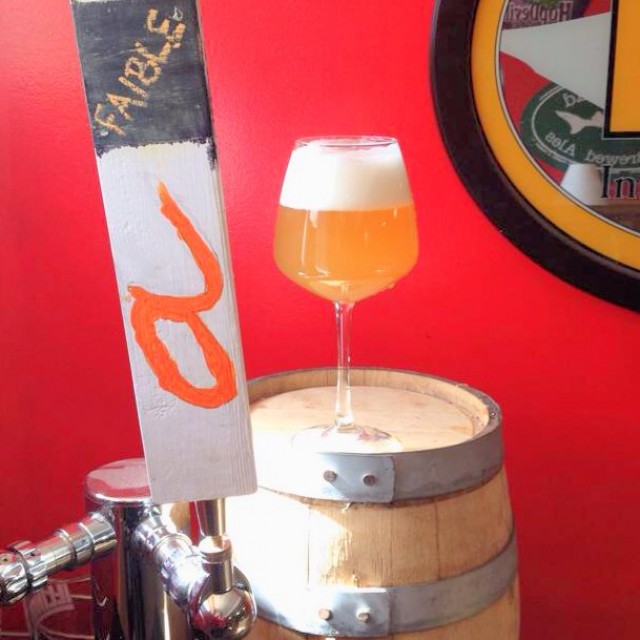This is my third time brewing Ruby, my Flanders Red Ale. The first batch was done in April 2012, and eventually was aged in a whiskey barrel. Unfortunately, this batch pre-dated me posting recipes, though hopefully I'll get tasting notes up for that eventually. The second batch was done in April 2013, and was bottled yesterday. I was really lax with notes on that one, as it was done right before we moved from Alexandria, Virginia back to Chicago last spring, so no post on that one either.
This recipe is quite similar to the base for the previous two, though this time I'm substituting in flaked maize for most of the wheat. I'll be using Roeselare for the entirety of this one, although may add dregs along the way. The first batch also used Roeselare and turned out quite well. The second batch was done with East Coast Yeast Flemish Ale (ECY02), courtesy of my friend Joe. Similar to batch 1, I will hopefully add in tasting notes for that one at some point.
The recipe for the full batch is as follows:
Batch Number: 81
Brew Date: February 23, 2014
Bottle/Keg Date:
Batch Size: 10 Gallon
OG: 1.050 (estimated)
FG: 1.002 (estimated)
Fermentation Temperature: ~65 F (ambient)
IBU: 19.1
ABV: 6.3% (est.)
SRM: 15.6
Mash: Single infusion for 60 minutes at 156 F.
Boil: 60 minute
Fermentables
9lb French Pilsner
4lb Munich Malt
2lb 8oz Maize, Flaked
1lb Wheat, Flaked
1lb Caramunich Malt
1lb Special B Malt
8oz Aromatic Malt
8oz Vienna Malt
Water
Mash Water: 6.6 gallons
Sparger Water: 7.7 gallons
Here, I added lactic acid to get the mash pH where I wanted it, and added enough calcium chloride to get the calcium level up past the recommended minimum of 50.
5.0g Calcium Chloride (all added directly to the kettle)
5mL Lactic Acid (88%) in the mash
Resulting water profile (based on EZ Water Calculator v3) is as follows:
Mash pH (est.): 5.44
Calcium: 59
Magnesium: 12
Sodium: 7
Chloride: 59
Sulfate: 27
I used lactic acid to adjust the pH of the sparge water, adding 5mL to the 7.67 gallons of water used for the sparge, which basic on the Homebrewing Physics calculator (available here), should give a sparge water pH around 5.0.
Hops
1.5oz Willamette (7.5 AAU), leaf, at 60 minutes
Other
2 tsp. Wyeast Yeast Nutrient at 10 minutes
Yeast
Wyeast Roeselare (1 packet for each 5-gallon portion)
Notes
02.23.2014: Brewday. Each carboy got 30 seconds of pure O2. The Roeselare packets were from October 29, 2013 and December 3, 2013. I mixed them in a sanitized measuring cup and split evenly between the carboys.
07.28.2014: Took one of the carboys out to the garage for a bit of mixing. The beer was moderately acidic, with a light lactic character along with a nice berry presence. Gravity was down to 1.008, and pH was 3.8. 3 gallons of it were added onto 6 pounds of black raspberries that we had picked in Michigan (and subsequently froze) over Fourth of July weekend, all into a 3-gallon Better Bottle.
The remaining portion was included in a blend for Science & Art #5.
 |
| Picking black raspberries in Southwest Michigan. Also found a baby bird. |
 |
| Adding the black raspberries to the carboy. |
 |
| Nice and purple. |
08.04.2014: After coming back from a nice weekend camping in Northern Michigan, the fermentation on fruit had really taken off. The liquid in the airlock was light purple, and a bit had spilled over onto the garage floor. Temperature during this time likely ranged from 70-75*F.
There was plenty of fruit pulp at the top that was not submersed in liquid. Fearing any sort of acetobacter infection due to exposure to oxygen, I utilized the "punch down" technique to get the berries back into liquid, and then replaced with a clean airlock. The punch down technique has been described on several occasions by Jester King, including here:
The blackberry refermentation involved a traditional wine making practice called a “punch down”. As the blackberries referment, they rise to the top of the oak barrel to form a cap. Several times a day we punched down the cap with a stainless steel mashing tool to break it up. This procedure was important to achieve good flavor and color extraction from the blackberries and to prevent the cap from drying up and becoming oxidized, which can lead to unwanted growth of acetobacter. Acetobacter, while harmless to consume, creates vinegary flavors and aromas that we dislike very much in beer. Punch downs and temperature control in our barrel room were important parts of our effort to keep acetobacter at bay.
11.01.2014: Was aiming to bottle the black raspberry version -- now named Amethyst -- but I had a ton of problems trying to bottle this with the Beer Gun out of the keg. So now it's sitting under pressure with the bottling sugar, conditioning in the keg. Based on this, it looks like I'll serve the beer on tap. In the future, I think fresh juice might be the way to go for raspberries and blackberries. They simply fall apart when left to ferment, and I'm not sure there's any benefit to having the whole fruit, as there isn't a pit or tannic skin to provide much additional flavor.
